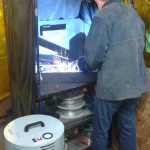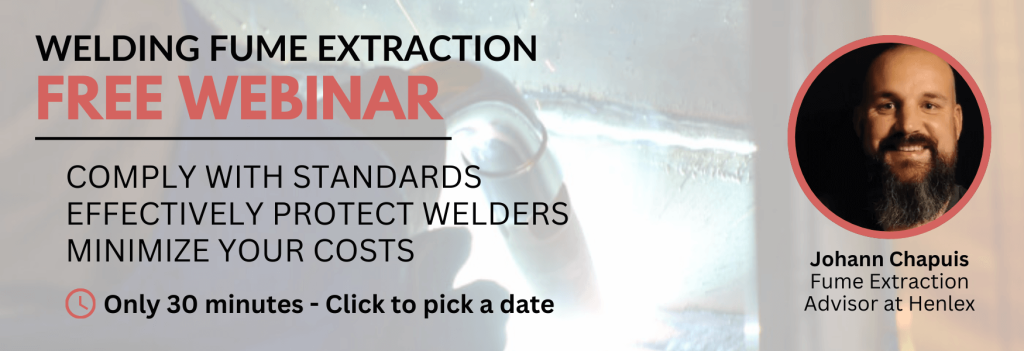Welding fume extraction is vital for maintaining a safe and healthy work environment. However, the effectiveness of this equipment largely depends on regular and proper maintenance. This article will explore the best practices for maintaining your welding fume extraction equipment.
It’s crucial to remember that while the guidelines provided here are broadly applicable, always refer to the manufacturer’s specifications for your specific equipment to ensure optimal care and safety.
Understanding Your Welding Fume Extraction System
A comprehensive understanding of your welding fume extraction system is fundamental to effective maintenance. These systems typically comprise several components:
- Vacuum Unit: The system’s heart generates suction to capture welding fumes.
- Dust Collector: This component filters and collects the extracted particulates and fumes. In stationary systems, it is a separate unit; in portable systems, it’s integrated with the vacuum unit.
- Ventilation Network includes ducts and hoses that transport fumes from the extraction point to the dust collector. In portable units the network is typically a simple hose, whereas stationary systems use a more complex arrangement of ducts and hoses.
- Extraction Tools: These tools capture welding fumes at the source and can include flexible arms, MIG extraction guns, nozzles, hoods, etc.
Establishing a Regular Maintenance Schedule
A well-planned maintenance schedule is essential for the longevity and efficiency of your welding fume extraction system. While the following outlines general guidelines and critical preventive maintenance tasks, it is vital to consult the manufacturer’s specifications for specific frequency and additional tasks.
Inspection and Cleaning Protocols (Weekly)
- Ducts and Hoses: Check for blockages, leaks, or wear to ensure unobstructed airflow.
- Vacuum and Dust Collector Units: Inspect for any signs of damage or malfunction. Clean the exterior and accessible interior parts to prevent dust accumulation.
- Extraction Tools: Ensure that tools like flexible arms and nozzles are free from obstructions and residue build-up.
Portable Units – Vacuum (Every 500 to 1500 hours of use)
- Motor Brushes: Regular inspection and replacement, per manufacturer’s guidelines.
Portable Units – Dust Collector (As needed)
- Filter Maintenance: Consistent checking and replacement of filters to ensure effective fume extraction (see next section).
- Dust Bin: Frequent emptying of the dust bin to prevent overflow and maintain suction efficiency.

Stationary Units – Vacuum (Every Trimester)
- Motor Maintenance: Routine greasing of motors for optimal performance.
- Vibration and Balance: Regular checks for vibrations and necessary adjustments for balancing (unusual noise can be a sign).
- Bearings and Belts (when applicable): Maintenance of bearings, including greasing or replacing lubrication systems, belt inspection (tension and condition) and replacement as needed.

Stationary Units – Dust Collector (As needed)
- Filter Maintenance: Regularly monitor and replace filters to maintain air quality (see next section).
- Dust Bin: Regularly empty the dust collector bin to ensure system efficiency and prevent clogging.

Each of these tasks plays a vital role in maintaining the functionality and safety of your welding fume extraction system. Adhering to this schedule will not only extend the life of your equipment but also safeguard the health of the workspace.
Any questions? Ask them directly in the chat at the bottom right of your screen or during one of our webinars.

Filter Maintenance and Replacement
Filters play a critical role in capturing and containing harmful particulates, and their proper upkeep is essential for system efficiency and workplace safety.
- Understanding Filter Types and Lifespan:
- Different systems use various filters (HEPA, activated carbon, etc.), each with a specific lifespan and efficiency rating. For welding, we recommend using a MERV-13 or higher.
- You should familiarize yourself with the filter type your system uses and its expected lifespan as per the manufacturer’s specifications.
- Recognizing the Need for Replacement:
- Most modern systems have filter change indicators or manometers that signal when filter efficiency is compromised. Here is a guide to help you know when to change the filter.
- Visible signs of wear, reduced suction, or increased visible emissions indicate that a filter needs replacement.
- Replacing Filters:
- Follow the manufacturer’s guidelines for filter replacement procedures to ensure correct installation and system compatibility.
- Ensure that replacement filters meet the necessary specifications for your system’s requirements.
- Handling and Disposal:
- Handle used filters with care, as they contain trapped particulates that can be hazardous.
- Dispose of used filters by local regulations and environmental guidelines.
Other Considerations
Checking Electrical Components
Electrical connections should be examined for corrosion or damage. Loose connections can lead to inefficiencies or safety hazards. When encountering electrical issues, seeking professional help to ensure accurate diagnosis and safe repairs is advisable.
Upgrading and Improving Your System
Keeping your system up-to-date with the latest technological advancements can significantly improve its efficiency and safety. Regularly assess the performance of your extraction system to identify potential areas for upgrades. It is essential to contact the manufacturer if you want to add more extractors to an existing installation to ensure performance.
Training Staff for Effective Maintenance
Proper training of staff in maintenance procedures is essential. Employees should know the routine tasks necessary to keep the equipment in good working order and be familiar with safety protocols.
Understanding the operation of the system enables staff to identify potential issues promptly. Encourage ongoing education to keep abreast of the latest maintenance techniques and safety standards.
Documentation and Record Keeping
Accurate record-keeping is a critical aspect of maintenance. Maintain detailed logs of all maintenance activities, including the dates of service, specific tasks performed, and any parts replaced.
These logs are a valuable record of the system’s history, tracking its performance and any significant repairs. These records are also crucial for demonstrating compliance with safety and environmental regulations.
Professional Maintenance and Support
Establishing a relationship with a professional maintenance service can be invaluable. Regular inspections by professionals can help identify issues that may not be apparent during routine checks. It’s also essential to have a plan for emergency services in case of sudden system failure.
Conclusion
The importance of regular maintenance in ensuring the safety and efficiency of your welding fume extraction system cannot be overstated. Adhering to these maintenance practices will not only extend the life of your equipment but also safeguard the health and safety of the working environment, and help reduce energy costs.
A well-maintained system is an essential investment in the overall well-being of your workplace.
3 Ways to Take a First Step Towards a Fume-Free Environment
1 – Attend Our Webinar

2 – Request our Compact Guide “30 Expert Tips for Eliminating Fume”
You will also receive information about regulations, success stories, tips to choose the right fume extractor.
This site is protected by reCAPTCHA and the Google Privacy Policy and Terms of Service apply.
3 – Contact Us
We would be pleased to help you protect your welders and comply with current standards. We travel everywhere in Canada and the United States for free demos.
1-800-922-2522
info@henlex.com
Or use our chat system at the bottom right corner get an answer to your questions now.

